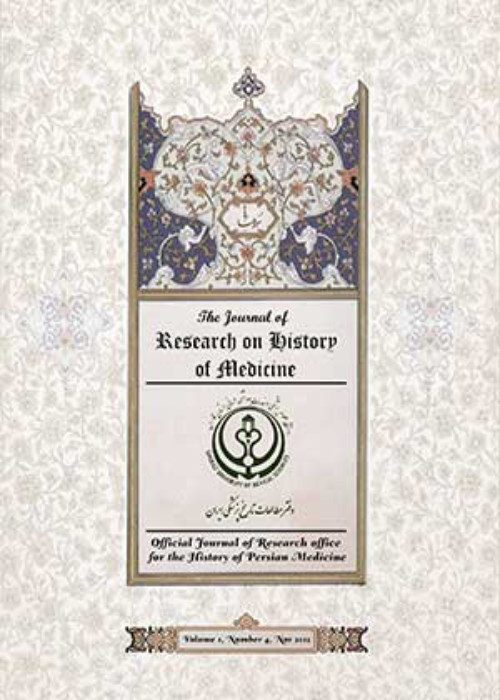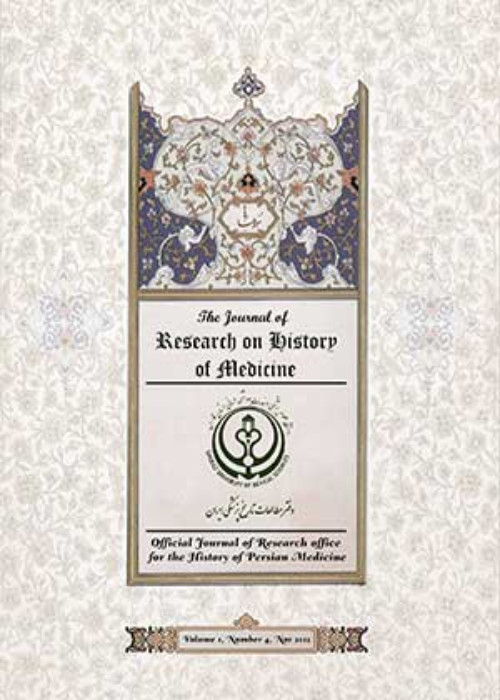فهرست مطالب

Journal of Research on History of Medicine
Volume:12 Issue: 1, Feb 2023
- تاریخ انتشار: 1402/01/22
- تعداد عناوین: 8
-
-
Pages 3-12Medical knowledge has developed in Shiraz since a long time ago due to the presence of expert and outstanding doctors. Najmuddin Mahmoud bin Sainuddin Elias Shirazi was one of the prominent doctors in Shiraz during the Ilkhanid period. He was reverenced by the rulers of Fars and the Ilkhanid governors. Teaching medical knowledge was one of Elias Shirazi’s essential activities and had a significant role in maintaining and continuing the development of medical expertise in Shiraz. Elias Shirazi was the head of Darwaza Salam Hospital in Shiraz and had a role in managing medical affairs in Fars. After the death of Najmuddin Mahmoud, prominent doctors were raised from his family; the most important of which was Mansour bin Muhammad bin Ahmed bin Yusuf bin Elias Shirazi. Elias Shirazi wrote many works, some of which have survived. His most important and famous work was the book Al-Hawi fi Elm al-Tadawi or Al-Hawi Saghir. This research uses a descriptive-analytical method based on library resources to explore the role of Najmuddin Mahmoud bin Sainuddin Elias Shirazi in the advancement of medical knowledge in Shiraz through investigating his biography, actions and works.Keywords: Medical Knowledge, Shiraz, Najmuddin Mahmoud bin Elias Shirazi, History of medicine, Persia, education, Biography
-
Pages 13-26Simultaneously with the compilation of the first hadith collections and the significant expansion of the production of works in various sciences in the 3rd century AH, the hadith collection of Al-Tibb al-Nabawī (Prophetic Medicine (PM)) was also compiled. The writing of this type of work continued in the following centuries. The current research aims to study and compare the historiography of these texts from the perspective of the purpose and motivation of their production, which lies in the content of the forewords and introductory chapters of those books. This study was conducted based on the thematic content analysis method in the oldest surviving and printed books in the field of PM from the 5th to 8th centuries AH.The results show that all the authors, except Ibn Qayyim, intended to make the mentality of their religious audience positive about the need to use the science of Medicine (both Greek and PM), presenting it as a religious matter. Damascene writers also had other motivations that were different from each other. Al-Maqdisi linked patience to illness, instead of suffering, with the elevation of one’s spiritual status. Davoud Mutatabib, however, introduced PM combined with Greek Medicine to approach God. In refuting his opinion, Ibn Qayyim emphasized that cognition and practicing PM is much more helpful than human and Greek medicine.Keywords: Al-Tibb al-Nabawī (Prophetic Medicine), Islam, Medicine, Historiography
-
Pages 27-34Melancholia is a Latin transcription of the Greek word melaina chole, which in ancient Greece mainly meant “biliousness,” and was also used, in medical speech “to signify insane or anxious conduct. In Unani system of medicine, Melancholia is classified into three categories according to the site affected by the disease. Persian scholars, including Rhazes, Ahmad bin Mohammad Tabri, Haly Abbas, and Avicenna, have given a detailed description of this disorder as a disease. Avicenna, in his treatise, The Canon of Medicine (Al-Qanun Fittib) has defined it as a kind of disorder in which imagination and judgment are so perverted that the victims become very sad and fearful. Some surveys were performed on Unani literature about melancholia and depression. The books consulted were mainly The Canon of Medicine (Al-Qanun Fittib), The Complete Book of the Medical Art (Kamil Sana), College (Kitabbul Kulliyat), Kitabul Umda Fil Jarahat, Tib Akbar. This study is constructed on a scrupulous overview of writings, compositions, and publications on melancholia and depression using internet sources like Web of Science, Scopus, PubMed, Google Scholar, Medline. There are numerous similarities between melancholia, a disease described in Unani system of medicine, and present-day depression, described in the conventional system of medicine. There are also a few differences between the two. Unani scholars were aware of psychiatric disorders and the concept is a collaborative effort of both ancient and conventional systems of medicine.Keywords: Melancholia, depression, Unani System of Medicine, Medicatrix naturae, Anxiety
-
Pages 35-50The medical evolution that occurred through the transition from traditional medicine to modern medicine, together with the arrival of foreign doctors in the Qajar era, was considered one of the most important social events in the field of medicine. This was enhanced by establishing hospitals and infirmary by missionary associations, which, in turn, contributed to improving the health level. The Missionary Association of the Church was one of the most important missionary associations that started its activity in the southeast of Iran due to the prevalence of various diseases, lack of public health, and shortage of medicine and treatment. This association pursued its activities by establishing schools, hospitals, and churches to propagate and spread Christianity. During this period, Kerman suffered from various diseases, and traditional medicine was far from providing effective treatment. Therefore, the agents of the CMS Association took an important step to treat patients. To this end, they established Morsalin Hospital.This article attempts to address the following question: what role and position did the missionary association of the church have in providing health services in Kerman? The current research was carried out in a descriptive-analytical way, taking a library approach. The research findings show that the doctors and nurses of the missionary association of the church have played an influential role in improving the health and treatment of people in the context of preaching and spreading Christianity.Keywords: Morsalin Hospital, Kerman, Church Missionary Society, Health, Treatment
-
Pages 51-62The objective of the present study is to elucidate the evolution of thoughts on urine inspection from antiquity to the present day. The classical Unani literature like Liber Regius, Canon of Medicine, Liber continens, Treasure of Khwarazamshah, etc. and the ancient literature of other traditional medicines like Ayurveda were prime sources of data. Additional sources were translations and summaries of the said classical books and scholarly articles written on the topic of urine. For recent advancements in uroscopy, browsing PubMed, Google Scholar, data science, and other trusted websites was carried out. Plentiful resources were frequently looked up and aided in the selection of topics for discussion in this review. With this intent, bibliographic research on the various classical literature was thoroughly sought out. In this regard, the classical literature of various traditional medicines was of immense help. Moreover, browsing trusted websites was carried out by searching for complementary and alternative medicine for uroscopy and urinalysis. Uroscopy has a long, colourful, and interesting history. The earliest evidence of urine inspection can be found in Babylonian, Sumerian, and Ayurvedic writings. Correspondingly, uroscopy has been practised for over 6,000 years. However, with the invention of the microscope, urinalysis became a valuable diagnostic tool in clinical practices. So essentially, urine represents a mirror image of the body’s states, such as health and disease. Besides, Urinalysis has been evolving from antiquity to the present day, from time to time.Keywords: Unani Medicine, Urine, Bawl, Uroscopy, Urinalysis, Matula, Qarurah
-
Pages 63-68
The Arab occupation of the Iberian peninsula had an important influence on the scientific development of Europe. Medicine at that time had a great influence on the classical authors, although the Muslim doctors Rhazes and Avicenna began to stand out, and had a very prominent influence until the Renaissance (Compier, 2012, pp. 3-25).The most important century of Spanish Arab Medicine is the 12th, in which the figures of Avenzoar, Averroes, and Maimonides appear, the latter being of Jewish origin (Martín-Araguz, et al, 2002, pp. 877-892). In previous centuries Ibn Habib, Abulcasis, Ibn Yulyul, Arid Ben Said El Kateb, and Abenguefit stood out (Tschanz, 2003, p. 9; Otero Tejero, et al, 2007, pp. 859-868). Without a doubt, and from the surgical point of view, we should center our interest on Abulcasis, as he was the first surgeon born in the Iberian peninsula to integrate the surgery into the doctrinal body of medicine, with the same category and level of knowledge.Abulcasis made an impact on the history of surgery with his multilevel work. Abulcasis was the first Arab-Hispanic doctor from Al Andalus who wrote a treatise on surgery (Amr, 2007, pp. 220-221). He was based on his predecessors of the Greek and Roman school of medicine as well as the Arabic knowledge in pharmacology (Markatos, 2019, pp. 2199-2203), but also he was a great innovator himself; he succeeded in inventing surgical instruments used in practice until nowadays in their most basic principle. Twelfth-century Latin translations of medical works written in Arabic have had a significant influence on the development of modern medicine (Masic, et al, 2017, pp. 364-372).
Keywords: Abulcasis, History of medicine, Arabic Medicine, Humanistic medicine, Surgeons -
Pages 69-76Mirza Abdolhossein Khan Bin Mohammadhasan Philosoph Al-Dawlah Zanozi (1866–1941 AD) was an apprentice of the French physician and epidemiologist during the Qajar Dynasty, Dr. Joseph Désiré Tholozan (1820–1897 AD). He wrote a book, entitled “Resaleh dar Maraz Anfeluaanza (Gerip)”, which was dedicated to Naser al-Din Shah Qajar (1831–1896 AD). Describing the Iranian influenza epidemic in 1890 and 1891 AD, this book is written using the method of European medical books but with the approach of Iranian traditional physicians. The present study is the correction and revision of “Resaleh dar Maraz Anfeluaanza (Gerip)” (1309 AH/1892 AD). The studies show that the treatise “Gerip” is the first Iranian scientific text that scientifically deals with influenza. Subjects, such as causes and origin of the outbreak, types of the disease, treatment methods, and manifestation of symptoms in the affected individuals are some of the distinctive and notable points of this work.Keywords: Mirza Abdolhossein Khan Philosoph Al-Dawlah Zanozi, Resaleh dar Maraz Anfeluaanza (Gerip), Influenza, History of medicine, 19th century, Iran


